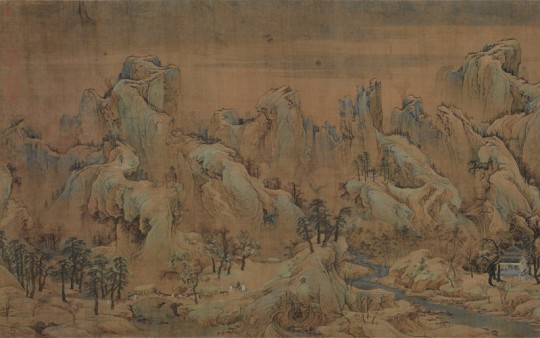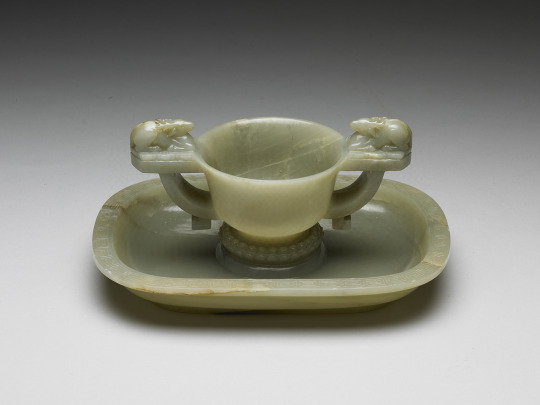Text

Autumn Colors along Rivers and Mountains 江山秋色圖
Handscroll. Ink and color on silk.
Height: 55,6 cm. Length: 232,2 cm.
Southern Song Dynasty (1127 AD –1279 AD)
This painting is attributed to Zhao Boju 趙伯駒 (born 1120-1130 AD; died 1162 AD). In order to better appreciate this masterpiece, one shall start by looking at the right edge of the painting ("the start") and slowly "travel" towards the left edge ("the end"). At first glance it might seem like there are no other elements other than the natural landscape, but watching closely, one can see that the artist did an extremely meticulous work: there are buildings perched between the mighty mountains, groups of people walking, and even a caravan towards the end of the scroll.

The painting is at present located in the Palace Museum of Beijing ( Gugong 故宫) and can be viewed at this link.
0 notes
Text

This object is a bi 壁 disc that dates back to the Eastern Han Dynasty period (25 BC - 220 AD). It is made of jade, measures 16,55 cm in height and has a diameter of 13,47 cm. It has the characteristic flat and circular shape of bi discs, however, what is immediately striking is the complex system of decorative motifs on the edge, characterized by inlaid spirals and by the presence of the characters chang 長 “long; forever” and le 樂 “happiness”, respectively placed on the upper and lower ends, similarly conveying the meaning of "eternal joy". The innermost part is decorated with rows of equidistant dots engraved on the smooth surface; this decoration is usually referred to as ‘rice-grain’ pattern. The story of bi discs dates back to Neolithic China, when their main purpose was ritualistic. Many bi discs were found in tombs, buried with the bodies of high social-status individuals. Scholars nowadays believe that the bi symbolized the tian 天 "sky" and that its peculiar form derived from the observation of sun's movement by the ancient Chinese population. Bi discs also appeared widely in Han burials.
This object is part of the permanent exhibition "Art in Quest of Heaven and Truth" at the National Palace Museum of Taipei.
7 notes
·
View notes
Text

Jade Cup and Saucer, Jade, Qing Dynasty (1644 AD - 1911 AD), Qianlong's Reign (1735 AD - 1796 AD).
Both objects are modest in size. The tray measures 17.6 cm long, 12.7 cm wide and is 2.4 cm high. The cup is 6.5 cm high and the flared edge makes it have a diameter of 7.4 cm.
The foot of the cup is characterized by the overlapping of two concentric circles, the smaller of which is embellished with two rows of small spheres in bas-relief. The central body is simple and devoid of decorations. On the two handles of the cup there are two small sculptures depicting two crouching deers. The choice of this animal is not random: it is in fact a symbol of longevity and prosperity. Since ancient China, the deer was believed to be an auspicious animal, capable of bringing happiness and longevity to human beings, as well as the chosen mount of the deities of immortality, often depicted on the back of a white deer. The presence of the figure of the deer on a jade artefact is nothing new: the first appearance of this animal as a decorative motif dates back to the distant Shang Dynasty (16th-11th centuries BC). The tray follows the simple and refined style of the cup, without decorations, except for the relief motifs on the edge. This decorative module is called yunleiwen 云雷纹, which means "cloud and lightning pattern". Typical of the Chinese artistic tradition starting from the Zhou Dynasty (1046 AD - 256 AD), it began to appear on the edges of jade works especially starting from the Song Dynasty (960 AD - 1279 AD). In the Qing era, this motif was further stylized, appearing as a series of juxtaposed square spirals.
The object is currently located at the National Palace Museum of Taipei and is part of the permanent exhibition "Art in Quest of Heaven and Truth".
1 note
·
View note